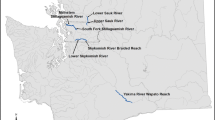Abstract
A methodology is presented to determine the optimal locations to place various types of developments in a watershed to reduce the changes in flow rates and volume from natural to developed conditions. An optimization model is developed which incorporates the hydrology (based upon rational method computations and a lag routing method) as constraints. The non-linear programming (NLP) model can be solved using Microsoft Excel (generalized reduced gradient (GRG)) procedure, or other NLP software. This model is meant to serve as a planning tool to help develop best management practices for regulatory agencies and to reduce cost of drainage facilities for developers. The model was applied to two examples to show its applicability and usefulness using Excel NLP software, which should enhance the availability of the modeling approach.




Similar content being viewed by others
References
Akan AO (1993) Urban stormwater hydrology—a guide to engineering calculations. Technomic, Lancaster. ISBN 0-87762-966-6
Akan AO, Houghtalen RJ (2003) Urban hydrology, hydraulics, and stormwater quality. Technomic, Lancaster. ISBN 0-471-43158-3
American Society of Civil Engineers (ASCE) (1996) Urban hydrology, Chapter 9, Hydrology handbook, ASCE Manuals and Reports on Engineering Practice No. 28, New York, NY
Behera PK, Papa F, Adams BJ (1999) Optimization of regional storm-water management systems. J Water Resour Plan Manag Am Soc Civ Eng 125(2):107–114
Bennett MS, Mays LW (1985) Optimal design of detention and drainage channel systems. J Water Resour Plan Manag Am Soc Civ Eng 111(1):99–112
Correia FN, Saraiva MD, Da Silva FN, Ramos I (1999) Floodplain management in urban developing areas. Part I. Urban growth scenarios and land-use controls. Water Resour Manag 13(1):1–21
Goff KM, Gentry RW (2006) The influence of watershed and development characteristics on the cumulative impacts of stormwater detention ponds. Water Resour Manag 20:829–860
Guo JCY (2001a) Design of off-line detention systems, chapter 8. In: Mays LW (ed) Stormwater collection systems design handbook. McGraw-Hill, New York
Guo JCY (2001b) Design of infiltration basins for stormwater, chapter 9. In: Mays LW (ed) Stormwater collection systems design handbook. McGraw-Hill, New York
James WP, Bell JF, Leslie DL (1987) Size and location of detention storage. J Water Resour Plan Manag Am Soc Civ Eng 113(1):15–28
Longanathan GV, Kibler DF, Grizzard TJ (1996) Urban stormwater management, chapter 26. In: Mays L (ed) Water resources handbook. McGraw-Hill, New York
Mays LW (2001) Stormwater collection systems design handbook. McGraw-Hill, New York
Mays LW (2010) Water resources engineering, 2nd edn. Wiley, Hoboken
Mays LW, Bedient PB (1982) Model for optimal size and location of detention basins. J Water Resour Plan Manag Am Soc Civ Eng 108(3):220–285
McCuen RH (1974) A regional approach to urban storm water detention. Geophys Res Lett 1(7):321–322
McCuen RH (1979) Downstream effects of stormwater management basins. J Hydraul Div Am Soc Civ Eng 105(11):1343–1356
Muleta MK, Nicklow JW (2004) Joint application of artificial neural networks and evolutionary algorithms to watershed management. Water Resour Manag 18(5):459–482
Ormsbee LE, Houck MH, Delleur JW (1987) Design of dual-purpose detention systems using dynamic programming. J Water Resour Plan Manag Am Soc Civ Eng 113(4):471–484
Paine JN, Akan AO (2001) Design of detention systems, chapter 7. In: Mays LW (ed) Stormwater collection systems design handbook. McGraw-Hill, New York
Papa F, Adams BJ (1997) Application of derived probability and dynamic programming techniques to planning regional stormwater management systems. Water Sci Technol 36(5):227–234
Park M, Chung G, Yoo C, Kim J-H (2012) Optimal design of stormwater detention basins using the genetic algorithm. J Civ Eng Korean Soc Civ Eng 16(4):660–666
Rao K, Kumar DS (2004) Spatial decision support system for watershed management. Water Resour Manag 18(5):407–423
Reichold L, Zechman EM, Brill ED, Holmes AH (2010) Simulation-optimization framework to support sustainable watershed development by mimicking the predevelopment flow regime. J Water Resour Plan Manag Am Soc Civ Eng 136(3):366–375
Stahre P, Urbonas B (1990) Stormwater detention. Prentice-Hall, Englewood Cliffs
Taur C, Toth G, Oswald GE, Mays LW (1987) Austin detention basin optimization model. J Water Resour Plan Manag Am Soc Civ Eng 113(7):860–878
Travis QB, Mays LW (2008) Optimizing retention basin networks. J Water Resour Plan Manag Am Soc Civ Eng 134(5):432–439
Tung YK (1988) Multi-objective detention basin design in urban drainage system tradeoff between risk and cost. Water Resour Manag 2:57–62
Urbonas B, Stahre P (1993) Stormwater: best management practices and detention for water quality, drainage and CSO management. McGraw-Hill, New York
Whipple W Jr, Kropp R, Burke S (1987) Implementing dual-purpose stormwater detention programs. J Water Resour Plan Manag Am Soc Civ Eng 113(6):779–792
Yeh C-H, Labadie JW (1997) Multi-objective watershed-level planning of storm water detention systems. J Water Resour Plan Manag Am Soc Civ Eng 123(6):336–343
Yen BC, Akan AO (1999) Hydraulic design of urban drainage systems, chapter 14. In: Mays LW (ed) Hydraulic design handbook. McGraw-Hill, New York
Author information
Authors and Affiliations
Corresponding author
Rights and permissions
About this article
Cite this article
Chill, J., Mays, L.W. Determination of the Optimal Location for Developments to Minimize Detention Requirements. Water Resour Manage 27, 5089–5100 (2013). https://doi.org/10.1007/s11269-013-0453-6
Received:
Accepted:
Published:
Issue Date:
DOI: https://doi.org/10.1007/s11269-013-0453-6




